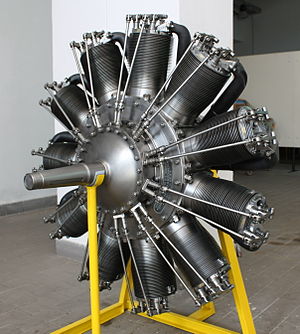Siemens-Halske Sh.III
| Sh.III | |
|---|---|
 |
|
| A Siemens-Halske Sh.III at Museo Storico dei Motori e dei Meccanismi, Palermo | |
| Type | Rotary engine |
| Manufacturer | Siemens-Halske |
Siemens-Halske's Sh.III was an 11-cylinder, air-cooled rotary engine developed in Germany during World War I, similar to the Sh.I.
It shared with its predecessor the unusual design feature of having its internal workings (crankshaft, connecting-rods, etc.) rotating in a clockwise direction as seen from "nose-on", within the engine, and the crankcase and propeller (still fastened to the crankcase, as is usual for rotary engines) rotating in the "accepted" anti-clockwise direction. Also unusual for a rotary engine was the inclusion of a true throttle control. Power was rated at 120 kW (160 hp).
The advantages of the engine were increased propeller efficiency through the reduction gearing effect of having the engine effectively running at 1,800 rpm for only 900 rpm of the airscrew, and excellent high-altitude performance due to the high compression ratio achieved. A bonus was the counter-rotating masses tended to cancel out the gyroscopic forces of the engine. This was achieved by using bevel-gears housed in the rear of the crankcase. This "contra-rotary" action also caused the point of ignition in the rotary action of the cylinders to itself slowly rotate in the direction of the crankshaft's rotation as the engine ran, as shown in the animation. For a normal rotary engine that had its crankshaft fastened to the airframe, the point of ignition always stayed in the same place in the cylinders' rotative action as they spun with the crankcase.
Production problems at the Siemens works, and poor quality lubricating oil, gave the Sh.III engines a life expectancy of only seven to ten hours before pistons began to seize. The license-built Rhemag versions of the Sh.III did not have such problems, so the Siemens-made engines were gradually withdrawn from service.
Data from
...
Wikipedia
